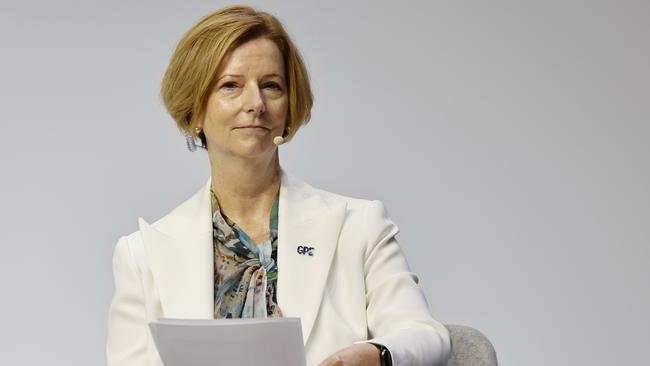Mexican standoff on border reflects challenge for Labor
US President Joe Biden is facing the same political pain over unwanted immigration that Kevin Rudd and Julia Gillard endured as prime minister.

The end of a US pandemic-era health regulation on Thursday (Friday AEST) known as Title 42, which allowed US border authorities to immediately expel asylum seekers ostensibly on health grounds, is expected to supercharge an already record influx of asylum seekers largely from central and South America.
“It’s going to be chaotic for a while,” Biden admitted on Tuesday, obscuring the fact it has been chaotic for some time.
In the three years to October this year, well over six million _people – about the population of Victoria – will have been apprehended by US authorities, and many more – perhaps another 20 per cent – will have managed to enter the US regardless.
Democrats criticised former president Donald Trump’s allegedly harsh border policies in the lead-up to the 2020 election, promising a fairer, more humane approach to asylum seekers, just as Labor did in Australia in the lead-up to the 2007 election.
But the ruling party now similarly finds itself having to toughen US immigration rules more than it would like, as a 2024 presidential election nears in which the US southern border crisis, and who’s to blame, will figure prominently.

More than 10,000 illegal immigrants a day were caught trying to cross the vast border between the US and Mexico – which is equivalent to the distance from Melbourne to Cairns – on the first two days of this week, a record level that could be dwarfed by the daily influx in coming weeks as the law reverts to the old Title 8.
In a desperate effort to bolster deterrence, the Biden administration has announced that potential immigrants who had not previously applied for asylum in nations they had passed through, such as Mexico, would never be granted asylum, a policy strikingly similar to former president Trump’s, which Biden once described as a source of “moral and national shame”.
To some extent, the new rules will be tougher than under Title 42. The administration has also announced an increase in financial penalties under Title 8 from $US50 to $US250 (a substantial sum for the largely low-income applicants), including the possibility of lengthy jail terms for asylum seekers who attempt to cross the border illegally.
Under Title 42, potential immigrants could try to cross as many times as they liked; from Thursday night, they will be barred from re-entry for five years after being rejected.
The federal government, which has already sent 1500 troops to help, has also promised thousands of extra contractors to help border patrol authorities and to expand detention facilities, and has granted new powers to officials to expedite reviews.
“These are policies designed to make it difficult or impossible for people in need of safety to get it, and even punish them for trying,” Heidi Altman, a director at the National Immigrant Justice Centre, told The New York Times this week.
A letter signed by 233 immigrant advocacy and humanitarian groups sent to the President last week urged the administration to abandon “policies that undermine their dignity, livelihoods, and human rights”, reflecting intense criticism within the Democratic Party.
Republicans, especially the governors of Texas and Florida, have made political hay with the border crisis, blaming Democrats for the surge and sending some asylum seekers to Democrat enclaves in the north of the country, including Martha’s Vineyard, to highlight the lopsided sharing of the immigrant burden across the US.
Trump, in his highly publicised CNN interview on Wednesday night (Thursday AEST), said that when Title 42 ended, it would be a “day of infamy” for the US. Republican House of Representatives Speaker Kevin McCarthy said on social media that the US was “hours away from utter chaos”.
Almost 60 per cent of American voters surveyed in seven battleground states disapproved of how Biden has handled the border issue, according to Democrat polling firm Global Strategy Group.

Vice-President Kamala Harris, who was publicly given responsibility for exploring solutions to the crisis by the President, has visited the southern border only once.
Immigration, most of it uncontrolled by modern standards, built the US, as it did Australia, in the 19th and 20th centuries, but for most voters today massive immigration has become politically toxic, amid high inflation, soaring house prices and a perception that migrants cause social and economic problems.
Soaring fentanyl deaths in the US, much of it coming across the southern border, has only fuelled its unpopularity.
It’s hard to see how the administration’s legal tweaks will make much difference, at least in the short term. Self-evidently, Title 42, a supposedly tough policy, failed totally to prevent the human tidal wave of the past few years. Deteriorating economic and social conditions in the US’s southern neighbours will continue to power the human exodus.
Republicans have promised to recommence building of a border if they win executive power in 2024, but that’s a long-term solution as at best the wall covers just a third of the 3145km border.
A mix of push and pull factors have contributed the crisis, and perception matters: Biden’s earlier rhetoric undoubtedly encouraged more asylum seekers to come than otherwise would have, illustrated by the sharp surge in arrivals after Trump left office.
The US problem should be a reminder to the new Labor government in Canberra not to repeat the mistakes of Rudd and Gillard years in rhetoric or policy.
Already, the number of known arrivals on boats to Australia, mainly from Sri Lanka, has leapt to 250 people since the federal election last year, after a long period of no arrivals at all.








US President Joe Biden is facing the same political pain over unwanted immigration that Kevin Rudd and Julia Gillard endured as prime minister, when hundreds of boats and thousands of people descended on Australia’s north, prompting an awkward and painful policy reversal.